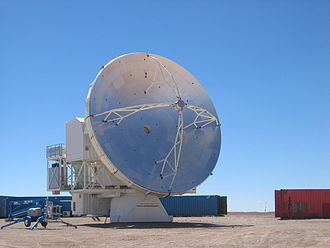Atacama Pathfinder Experiment
|
Telescope Atacama Pathfinder Experiment |
|
|---|---|

|
|
| APEX telescope | |
| Type | Radio telescope |
| Location |
San Pedro de Atacama , Llano de Chajnantor
|
| height | 5107 m above sea level M. |
| Geographic coordinates | 23 ° 0 '20.8 " S , 67 ° 45' 33" W |
| wavelength | 0.2-2 mm |
| Aperture |
|
| Installation | 2005 |
The Atacama Pathfinder Experiment ( APEX ) is a radio telescope with a reflector diameter of 12 meters in the Chilean Atacama Desert . APEX was jointly set up by the Max Planck Institute for Radio Astronomy (MPIfR), the European Southern Observatory (ESO) and the Swedish Onsala Space Observatory (OSO) at the location of the Atacama Large Millimeter Array (ALMA) radio interferometer . This is about 5100 meters above sea level on the Chajnantor high plateau in northern Chile, which is particularly suitable for astronomical observations in the submillimeter and millimeter range due to its thin and dry air. APEX works at 0.2 - 2.0 mm wavelength. The telescope is a slightly modified prototype of an ALMA antenna, in particular the two Nasmyth cabins offer additional space for receivers.
The first scientific observations with APEX were carried out in summer 2005. The scientific focus of the telescope is on the study of star formation and the universe at large redshifts .
It is part of the Event Horizon Telescope project and was one of the telescopes of the worldwide network of eight radio telescopes, with which in 2017 (published in April 2019) the first direct images of a black hole (the supermassive black hole in M87 ) were obtained.
Web links
Individual evidence
- ↑ APEX homepage
- ^ Güsten, R., et al. "The Atacama Pathfinder EXperiment (APEX) - a new submillimeter facility for southern skies -." Astronomy & Astrophysics 454.2 (2006): L13-L16. ( PDF )